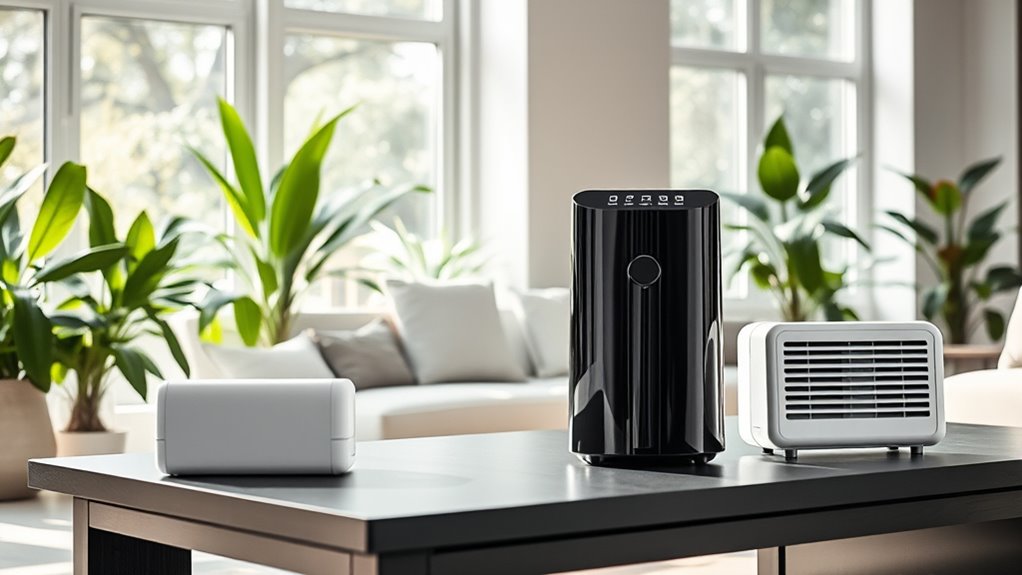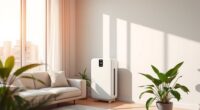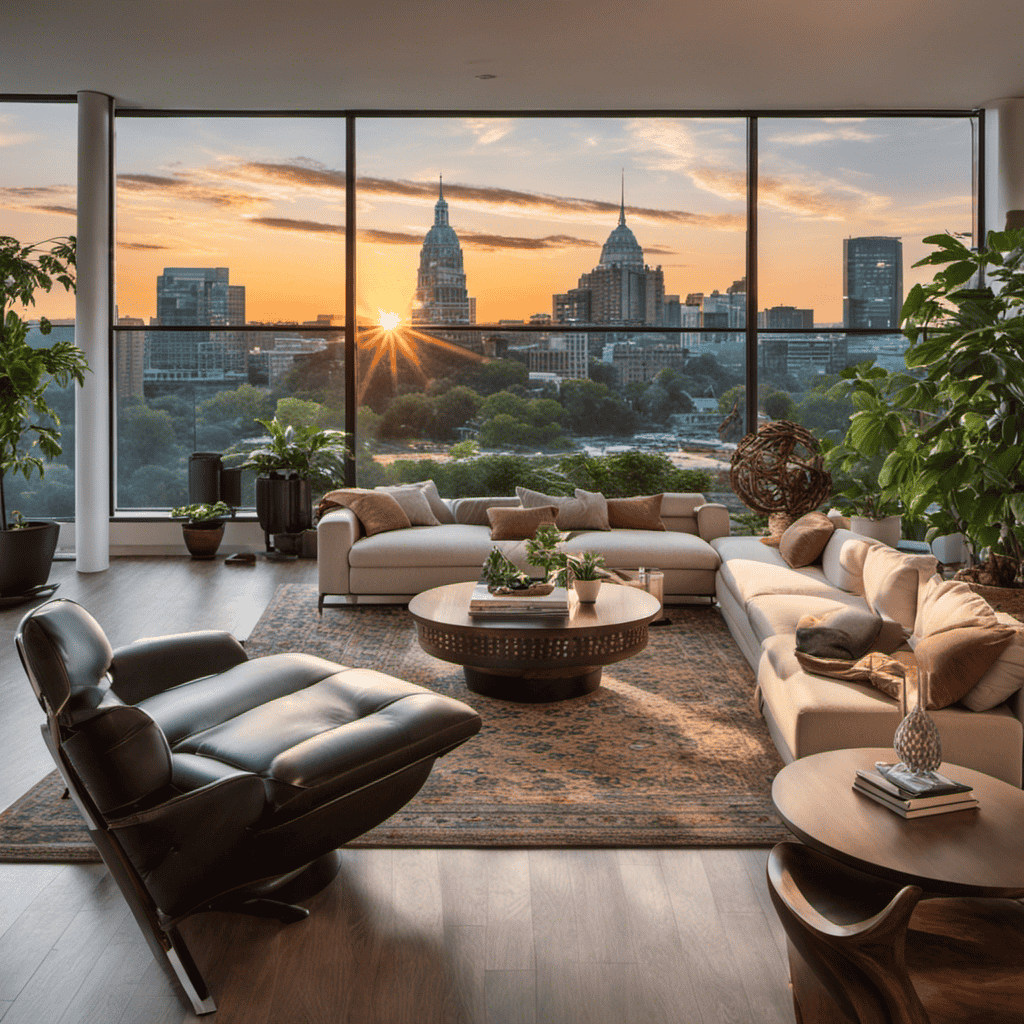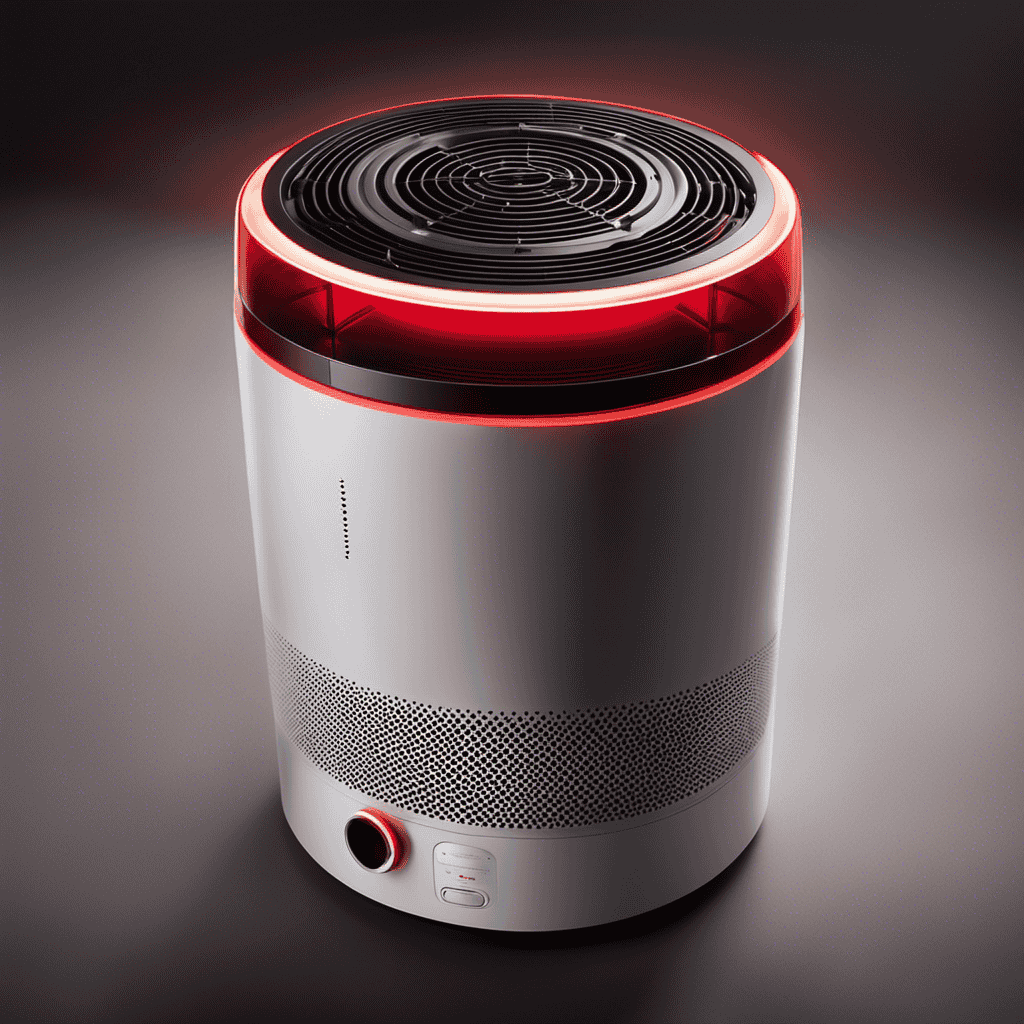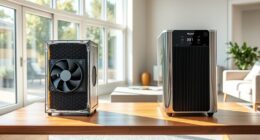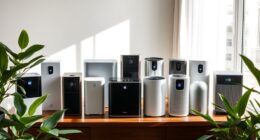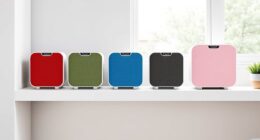Expensive air purifiers are often worth the investment because they typically offer better filtration, longer-lasting build quality, quieter operation, and energy efficiency. They often have advanced features like smart controls and real-time air quality monitoring, which boost their performance and convenience. While they cost more upfront, they can save you money in the long run through reduced maintenance and lower energy bills. Keep exploring to see if a premium unit suits your needs and budget.
Key Takeaways
- Expensive purifiers often feature advanced multi-stage filters, longer lifespan, and better durability, offering superior long-term value.
- High-end models typically operate more quietly and efficiently, enhancing user comfort and reducing energy costs over time.
- Budget units may lack sophisticated features like real-time air monitoring or smart controls, limiting their overall effectiveness.
- Investing in premium purifiers can be justified for severe pollution, health concerns, or long-term savings despite higher initial costs.
- Overall, the value of expensive air purifiers depends on individual needs, space size, and willingness to invest in durability and advanced features.
Comparing Filtration Technologies and Effectiveness

When comparing filtration technologies, it’s clear that not all air purifiers are created equal in their ability to remove pollutants. Different filtration types, like HEPA, activated carbon, and UV filters, offer varying levels of effectiveness. HEPA filters excel at capturing tiny particles such as dust, pollen, and pet dander, making them highly effective for allergy sufferers. Activated carbon filters target odors and chemical fumes, providing a different kind of protection. UV filters can neutralize bacteria and viruses, adding another layer of defense. An exhaustive comparison reveals that while some models combine multiple filtration types for all-encompassing coverage, others rely on a single method. Choosing the right air purifier depends on your specific needs and the pollutants you want to eliminate, ensuring you get the best value for your investment. Additionally, advanced filtration technologies can further enhance the overall effectiveness of air purifiers, especially in environments with complex pollutant profiles. Incorporating multilayer filtration can help target a broader spectrum of airborne contaminants for comprehensive air quality improvement.
The Impact of Air Purifier Size and Coverage Area
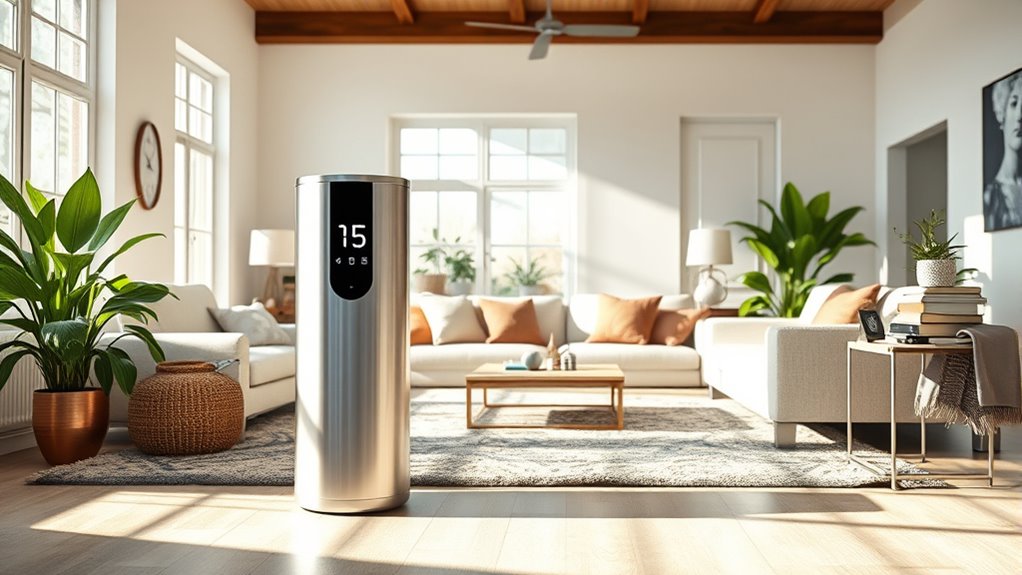
The size of an air purifier and its coverage area directly influence its effectiveness in filtering your space. If your room size exceeds the purifier’s coverage area, air cleaning becomes less efficient, leaving pollutants behind. For optimal performance, selecting a unit with an appropriate air change rate ensures the air is refreshed adequately and pollutants are effectively removed. Choosing a purifier with the right filter type can also impact how well it captures different airborne contaminants. For smaller rooms, a compact purifier with a limited coverage area might suffice, but larger spaces require models designed for greater coverage. When choosing between expensive and budget options, consider their recommended room size. An expensive unit often offers a larger coverage area, making it suitable for open-plan living areas or multiple rooms. Conversely, budget models may only effectively filter smaller spaces. Matching the purifier’s coverage area to your room size ensures you get ideal air quality without wasting money on overpowered units or settling for underperformers. Additionally, understanding ventilation and air exchange rates can help you optimize your space for better air quality and comfort. Investing in a purifier with appropriate air exchange rates can significantly enhance overall air purification efficacy.
Noise Levels and User Comfort
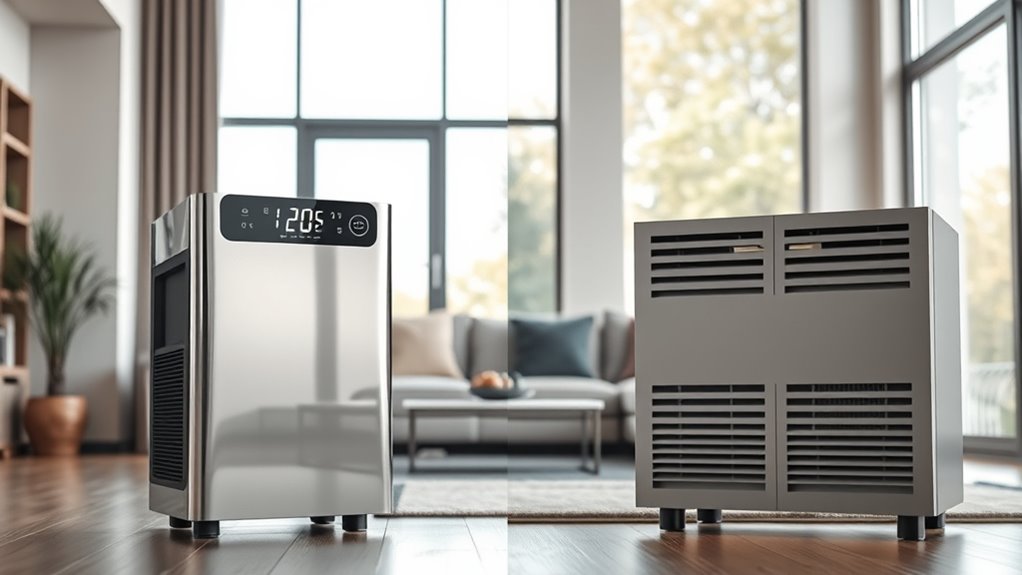
While air purifiers effectively improve indoor air quality, their noise levels can considerably impact your comfort and daily routines. If an air purifier is too loud, it can disrupt sleep, work, or relaxation, reducing overall noise comfort. Budget models often generate more noise, which may lead to frustration and a poor user experience. On the other hand, higher-end units tend to operate more quietly, enhancing your comfort during extended use. When choosing an air purifier, consider the noise level settings and how they align with your environment. A quieter device can make a significant difference in your daily life, ensuring you benefit from cleaner air without sacrificing peace and quiet. Additionally, noise levels are a critical factor in determining overall user satisfaction with an air purifier. Moreover, understanding the automation of modern devices can help you select models that adapt to your needs for optimal comfort. Features such as adaptive fan speeds help maintain a balance between performance and noise, providing a more personalized experience. A well-designed user interface can also simplify adjustments and improve overall satisfaction. In addition, sound design principles can be applied to optimize the acoustic performance of air purifiers, making them less intrusive in living spaces. Ultimately, balancing noise levels with performance is key to a satisfying user experience.
Energy Consumption and Operating Costs
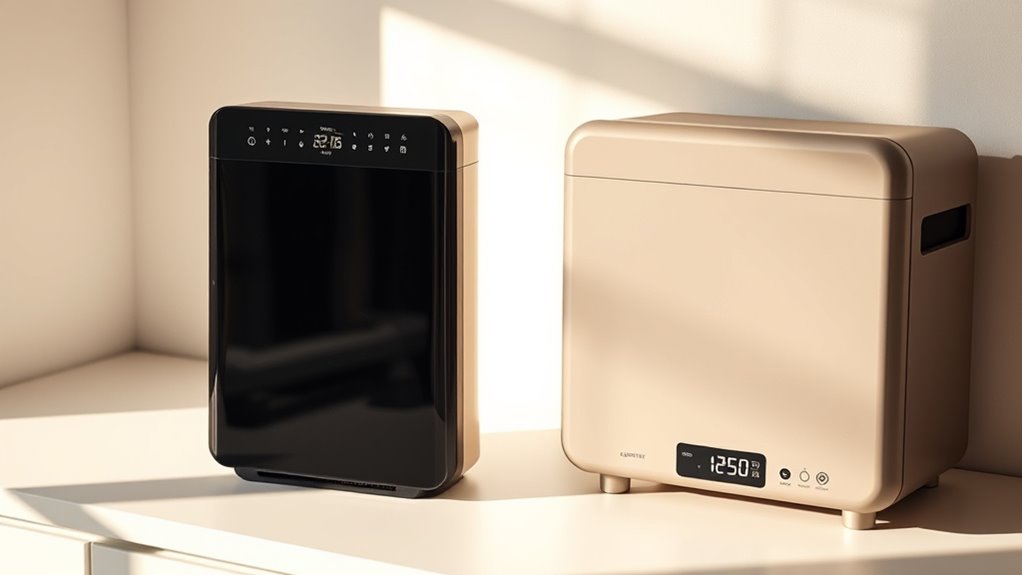
Higher-end air purifiers often use more power, which can increase your energy bills over time. However, they may also run more efficiently and last longer, helping you save money in the long run. Considering these factors can help you choose a model that balances upfront costs with ongoing expenses. Additionally, understanding the security features of these devices can help ensure your home remains safe while using advanced technology. Moreover, selecting energy-efficient models with high efficiency ratings can further reduce operational costs over their lifespan. Evaluating long-term savings can also provide insight into whether the initial investment is justified by future cost reductions, especially when considering the performance features that contribute to better air purification and energy use. Incorporating power consumption data into your decision process can help you identify models that offer optimal performance with lower energy costs.
Power Usage Differences
Although expensive air purifiers often boast advanced features, they typically consume more energy than budget models, leading to higher operating costs over time. Their power consumption varies based on design and features, impacting overall energy efficiency. To compare, consider the following:
| Model Type | Power Consumption | Energy Efficiency |
|---|---|---|
| High-end Purifier | 100-150 watts | Usually more efficient |
| Budget Model | 50-80 watts | Varies, often less efficient |
| Features Impact | Additional features increase power use | Can improve energy efficiency with smart tech |
| Usage Duration | Longer use raises costs | Shorter use saves energy |
| Overall Cost | Higher for expensive models | Depends on efficiency and use |
Your choice affects daily energy costs, so understanding power consumption differences helps determine value. Energy consumption is a critical factor when evaluating different air purifier models to ensure cost-effective operation over time. Additionally, some high-end models incorporate smart technology that can optimize power use based on room conditions, potentially reducing operating costs. Recognizing the significance of energy efficiency can help consumers make informed decisions that balance performance and cost savings.
Long-term Cost Savings
Long-term cost savings hinge on how much energy your air purifier consumes and the operating costs that come with it. While expensive models often have energy-efficient features, you’ll also want to think about air quality monitoring capabilities that help optimize usage, reducing unnecessary power draw. Additionally, check the air purifier warranties, as longer coverage can save money on repairs and replacements over time. Keep in mind these factors:
- Lower energy bills from efficient operation
- Reduced maintenance costs with durable build quality
- Better air quality monitoring minimizes wasteful operation
- Extended warranties decrease long-term repair expenses
- Some models with advanced features offer enhanced energy efficiency and smarter operation, contributing to long-term savings. Implementing energy-saving technologies can further enhance these benefits by optimizing power consumption. Exploring smart technology integrations can help ensure the unit operates only when necessary, further reducing costs.
Investing in models with smart technology can further optimize energy use and improve overall efficiency. Choosing a model with smart features and solid warranty coverage ensures you’re not only investing in cleaner air but also maximizing savings over its lifespan. Ultimately, balancing upfront costs with long-term savings depends on these key considerations.
Features and Smart Capabilities

Smart features can make a big difference in how you use your air purifier, especially with app control and automation. Budget models often lack these capabilities, while expensive units offer seamless integration with your smart home system. Consider whether these features align with your needs before making a choice. Incorporating glycolic acid technology in skincare products demonstrates the importance of advanced features in enhancing performance and user experience.
Smart Features Integration
Have you ever wondered how smart features can enhance your air purifier experience? Modern models often include air quality sensors that monitor pollutant levels in real-time, adjusting operation automatically for ideal air quality. Voice assistant integration lets you control your device hands-free, making adjustments simple and convenient. These features improve user experience by providing seamless control and real-time feedback. Consider these benefits:
- Instant updates on air quality status
- Automated adjustments based on sensor data
- Easy voice commands for quick control
- Enhanced convenience without needing an app
Smart features make your air purifier more responsive and user-friendly, especially when you want effortless operation and precise air quality management. While these integrations can add cost, they offer significant control and peace of mind.
App Control and Automation
App control and automation capabilities allow you to manage your air purifier remotely through smartphone apps, giving you the convenience of adjusting settings anytime, anywhere. With a user-friendly interface, you can easily monitor air quality levels, change fan speeds, or switch modes without leaving your seat. A remote control feature lets you operate the device from a distance, adding flexibility to your routine. Smart automation lets your purifier respond automatically to air quality changes, saving you time and effort. Higher-end models often offer more sophisticated controls and customizable routines, making them more convenient. Budget models may have basic app features, but expensive purifiers usually provide more seamless integration and advanced automation options. Overall, app control enhances user experience and keeps your air cleaner with minimal hassle.
Longevity and Maintenance Requirements
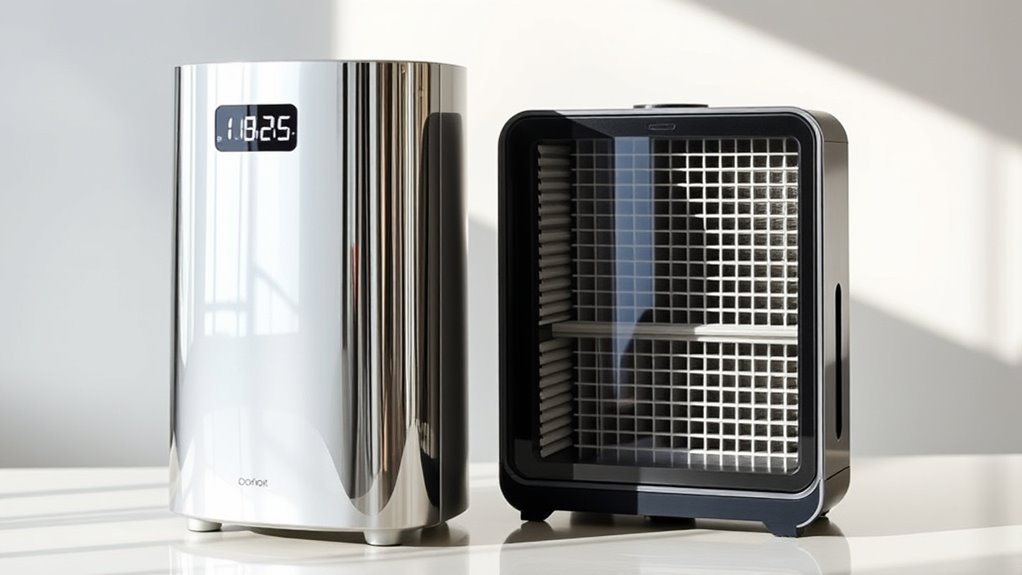
When comparing expensive air purifiers to budget models, longevity and maintenance requirements play a essential role in your decision. Higher-quality units often have better device durability, meaning they last longer with proper care. You may find that filter replacement intervals are less frequent or easier to perform on premium models, reducing ongoing hassle. Budget models might require more frequent filter changes, which can add to long-term costs. Consider these factors:
- Longer-lasting filter materials reduce replacement frequency
- Durable construction withstands wear and tear
- Easier access for maintenance saves time
- Lower overall maintenance costs over time
Ultimately, investing in a more durable device can mean fewer interruptions and lower maintenance efforts, making it a smarter choice in the long run.
Price and Value for Money

While expensive air purifiers often come with higher upfront costs, they tend to offer better overall value by delivering superior filtration, durability, and advanced features that enhance air quality and convenience. When doing a price comparison, you’ll notice that premium models usually last longer and require fewer replacements, reducing long-term expenses. A thorough value assessment shows that investing more initially can save you money over time, thanks to better performance and fewer maintenance needs. Cheaper models might seem appealing at first, but they often lack the features that improve efficiency and air purification quality. Ultimately, weighing the higher initial price against the long-term benefits helps you determine if the extra investment is justified for your specific needs.
When to Invest in a Premium Model
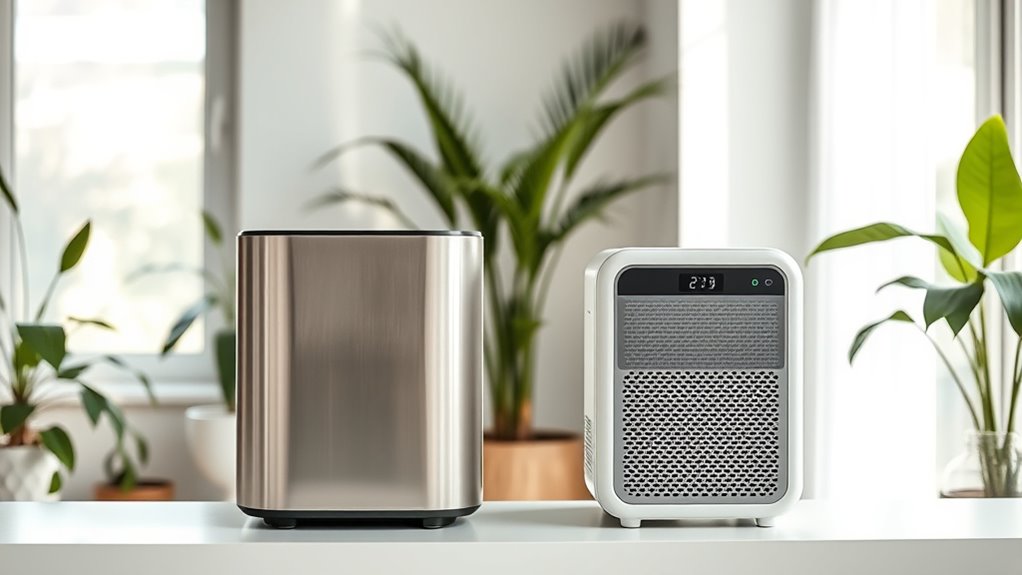
Choosing the right air purifier depends on your specific needs and circumstances. Consider a premium model when a thorough cost benefit analysis justifies higher upfront and maintenance costs, especially if you need superior filtration for allergies, asthma, or chemical sensitivities. Also, evaluate your lifestyle compatibility—if you spend a lot of time at home or prioritize indoor air quality, investing in a high-end unit makes sense.
You might want to upgrade if:
- You’re dealing with persistent or severe indoor pollutants
- You require advanced features like smart controls or quiet operation
- Your existing budget allows for a long-term investment
- You value convenience and durability over frequent replacements
A premium model can provide peace of mind and better health outcomes, making it a worthwhile choice when these factors align with your lifestyle.
Frequently Asked Questions
How Do Air Purifiers Affect Overall Indoor Air Quality Long-Term?
You’ll notice that air purifiers improve indoor air quality over time by increasing air exchange and enhancing pollutant filtration. As they run regularly, they remove allergens, dust, and airborne toxins, making your space healthier. Long-term use helps maintain cleaner air, especially in areas with high pollution or poor ventilation. While higher-end models often offer better filtration, consistent operation of any quality purifier steadily improves your indoor environment.
Are There Health Benefits Exclusive to High-End Air Purifiers?
You might think high-end air purifiers offer exclusive health perks, but the truth’s a bit ironic. They often feature advanced HEPA filtration and air quality sensors, yet budget models also improve air quality considerably. The real benefits come down to your specific needs. If you have allergies or asthma, investing more could help, but for general use, a mid-range purifier with solid HEPA filters might suffice.
Can Budget Models Effectively Remove All Indoor Pollutants?
You might wonder if budget air purifiers can fully remove indoor pollutants. While they often have decent filtration efficiency, their ability to target all particles may be limited compared to pricier models. Brand reputation also influences performance; trusted brands typically offer more reliable filtration. If you’re aiming for thorough purification, investing in a reputable, higher-end model could be more effective, but budget options can still improve indoor air quality.
Do Premium Air Purifiers Improve Allergy Symptoms More Than Cheaper Ones?
Premium air purifiers often feature advanced HEPA filters that capture smaller allergens, which can help reduce allergy symptoms more effectively than cheaper models. They also tend to operate quietly, with lower noise levels, making them more comfortable for daily use. If you suffer from allergies, investing in a higher-quality purifier might improve your comfort and health, especially if it’s designed to target specific indoor allergens with superior filtration and quieter operation.
How Do Maintenance Costs Compare Between Expensive and Budget Models?
You might find it surprising, but maintenance costs often align more closely than you expect. Expensive air purifiers usually have longer-lasting filters, reducing replacement frequency, though their filters tend to cost more. Energy consumption varies; premium models often operate more efficiently, saving you money over time. Budget models may have cheaper filters but could need more frequent replacements and higher energy use, balancing out costs in the long run.
Conclusion
So, next time you’re tempted by those flashy, expensive air purifiers, remember—they might just be the fancy gadgets that do the same job as budget models. Sure, you could spend a fortune for extra features or sleek design, but in the end, clean air is what matters most. Sometimes, the best investment is realizing that a basic purifier can do the job just fine—who knew?
